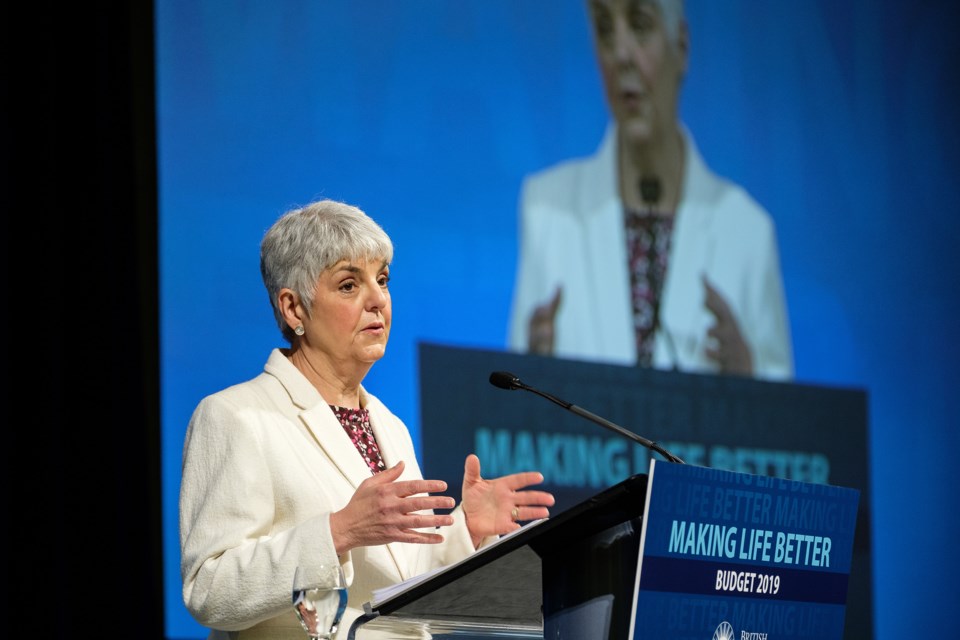Families with children and young adults with student loans were big winners in B.C.’s 2019 budget announcement, but regular classrooms didn’t get a whole lot of love.��
B.C.’s Finance Minister Carole James announced, on Feb. 19, the $380-million B.C. Child Opportunity Benefit, which will give families with children up to age 18 as much as $3,400 a year. The new benefit, which kicks in October 2020, will be combined with the early childhood tax benefit, which is only paid for kids up to age six. Families earning up to $97,487 a year will be eligible for the benefit.��
The budget is balanced and does not bring in any no new tax measures. Families earning $80,000 a year will pay nearly $2,000 less in taxes by the time the measures are fully implemented, compared to what they paid in 2016, a chart in the budget shows.��
James called the new child tax credit a “historic investment,” saying the benefit will help both the middle class and people living in poverty.��
“For anyone who has raised a child, they know how transformational that kind of support will be,” James said. “From the ability to put healthy meals on the dinner table, to being able to buy your child a good winter coat, that kind of support is going to make an incredible difference.”��
Vivica Ellis, from the Single Mothers’ Alliance of B.C., said the new benefit is a “powerful new tool to combat child poverty,” which the government has pledged to reduce by 50 per cent over five years.��
“Unfortunately, the full power of this tool is eroded by setting the threshold for the maximum benefit at $25,000, which means many single mothers and other families will see their benefit reduced while they are still below the poverty line,” Ellis said in a news release.��
James also eliminated interest on provincial student loans, effective now.��
“Students and young families with loans will save an average of $2,300 after graduation, so they can start their careers off on the right foot,” James said.��
The kindergarten to Grade 12 budget gets an increase of $550 million over three years to cover growing enrolment and the extra teachers and support staff required to meet the 2016 Supreme Court of Canada decision on class size and composition. Education funding to school districts is now $5.97 billion a year.
Beyond those basics and $2.7 billion to maintain and replace schools, there was little in the budget for public schools.��
Clint Johnston, second vice-president of the B.C. Teachers’ Federation who was filling in for president Glen Hansman, said teachers are happy to see the social spending on childcare and housing, but the operational funding for schools could fall short of addressing the teacher shortage.��
“It’s a bit concerning with the current situation with recruitment and retention and we know we need teachers still,” Johnston said. “What’s there is money that is pretty much all spent.”��
He said the nearly 4,000 new teaching positions funded by the government are all a result of the teachers’ Supreme Court win in 2016 and that is what is driving the reduction in class sizes and the increases in supports for students with special needs.��
“After 16 years of cuts under the previous government, those caps and ratios now need to be improved,” he said.
A controversial report with plans to drastically change how schools are funded, particularly when it comes to students with special needs, was released in December, but changes are on hold pending consultation. Another looming event is the expiry of the teachers’ contract this June and the costs that could accompany a significant teacher wage increase or other contract changes.��
Nonetheless, the government did commit to continue its $1.3-billion investment in child care and its plan to make housing more affordable, both announced last year. The budget also allows for enhanced mental health care for children and youth and increased payments to foster parents and extended family members caring for children in care.��
The budget also increases income and disability assistance rates by $50 a month, but details of the complete poverty reduction plan won’t be announced until the spring. As previously announced, Medical Services Plan premiums will be completely eliminated as of January 2020.��
It’s mostly a hold-steady budget, with a couple of spending announcements. Pending the outcome of both the teachers’ contract negotiations and the funding model consultations, next year the education budget could see a significant increase.��
��



